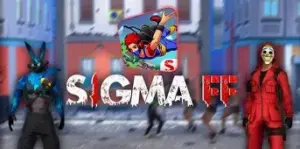The gaming community has been buzzing about Sigma FF, often referred to as the “low-budget Free Fire.” This game gained huge attention among players because of its striking similarity to Free Fire, one of the most popular battle royale titles in the world. Many fans were curious to explore Sigma FF as it promised lightweight gameplay, smaller storage requirements, and battle royale action that closely resembles the original. However, the story of Sigma FF is more complex than it seems, involving popularity, controversy, and discussions about copyright.
In this article, we’ll take a deep dive into Sigma FF, its features, why it became popular, and how it connects with the broader Free Fire universe.
What is Sigma FF?
Sigma FF is a battle royale game that looked almost identical to Free Fire in terms of graphics, user interface, and gameplay. It was designed as a lighter version, allowing players with low-end smartphones to enjoy a smooth battle royale experience without needing high storage or RAM.
The game promised:
- Quick battle royale matches with reduced maps.
- Lighter graphics, making it easy for entry-level devices.
- Similar characters, skins, and weapons inspired by Free Fire.
- Multiplayer action that gave fans a familiar experience.
This resemblance is exactly what attracted Free Fire fans, but it also raised big questions about originality.
Why Did Sigma FF Become Popular?
The sudden rise in popularity of Sigma FF was no accident. Gamers, especially in regions like India, Brazil, and Southeast Asia, were looking for alternatives after Free Fire faced a temporary ban in some countries. Sigma FF arrived at the right time, offering players a way to relive the battle royale action they were missing.
Key Reasons Behind Its Popularity:
- Lightweight Gameplay – Unlike Free Fire Max, Sigma FF was designed for low-end devices, attracting players who faced lag and storage issues.
- Free Fire Similarity – The UI, maps, and characters looked familiar, making players feel at home instantly.
- Curiosity Factor – Many gamers wanted to test whether Sigma FF could replace Free Fire or at least provide a similar experience.
- Viral Marketing – Word of mouth, social media posts, and gaming YouTubers gave it massive traction in a very short time.
Controversy Around Sigma FF
While Sigma FF gained massive downloads quickly, it also sparked huge controversy. The main issue was its close resemblance to Free Fire. Many players called it a clone, and legal discussions soon started about whether it was infringing on copyrights.
Game publishers usually take strict action when another game copies their content, and the situation with Sigma FF was no different. This led to the game being taken down from official stores, leaving players questioning its future.
Free Fire vs Sigma FF: What’s the Difference?
Even though Sigma FF looked like Free Fire, there were some differences worth noting:
- Graphics Quality: Sigma FF had downgraded graphics for smooth performance, while Free Fire (and especially Free Fire Max) offers more polished visuals.
- Storage Requirements: Sigma FF required much less space, whereas Free Fire Max needs more storage and better hardware.
- Gameplay Features: Free Fire offers diverse events, esports tournaments, and seasonal updates. Sigma FF had limited features due to being new and unofficial.
- Official Support: Free Fire is backed by Garena with strong community support, while Sigma FF lacked such resources.
The Future of Sigma FF
Currently, Sigma FF faces an uncertain future. Many players downloaded it for fun, but without official backing, it’s unlikely to become a long-term replacement for Free Fire. Still, its popularity highlighted something important: there’s a huge demand for lightweight battle royale games that run smoothly on all devices.
This could inspire developers to release official lighter versions or new games tailored for players with budget smartphones. For now, Free Fire and Free Fire Max remain the leading choices for battle royale lovers worldwide.
Lessons from Sigma FF for Free Fire Fans
The Sigma FF story gives us a few insights into the gaming world:
- Originality Matters – Cloning a successful game might bring short-term attention but doesn’t guarantee long-term success.
- Demand for Lite Versions – Gamers with low-end devices want lightweight options, which Free Fire once provided with its original version.
- Community Power – The reason Sigma FF spread so fast was because of the strong Free Fire fan community.
Conclusion
Sigma FF made headlines by presenting itself as a lighter version of Free Fire, quickly attracting attention in the gaming community. However, its lack of originality and legal concerns led to controversy and an uncertain future. Despite this, the game highlighted the continued love for Free Fire and the demand for accessible, low-storage battle royale experiences.
For gamers, Sigma FF was an interesting experiment, but Free Fire remains the dominant name in mobile battle royale gaming.
Also Read: Valorant Account Recovery – Restore Your Riot Games Account
